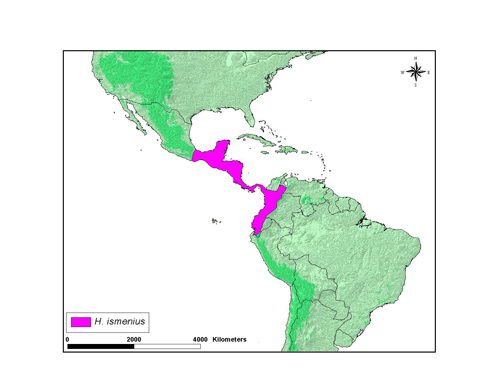Heliconius ismenius
Margarita BeltránIntroduction
Etymology: ISMENOS or Ismenius was a River god of Boiotia, in central Greece (Ismenos). There were two distinct, parallel, traditions about the god of the river Ismenos. The first of these names is the god Ladon, a son of the Boiotian river-god Asopos, and grandson of the like-named Arkadian river Ladon. His streams were later renamed in honour of Ismenos a son of King Amphion of Thebes who was slain by Apollon. The second version names the first god of the river Kaanthos. When Apollon carried off his sister Melia, the Naias of his Ismenian spring, he set fire to the god's Theban temple in retribution. Apollon was furious and shot him dead. In his stead he was succeeded as god of the river by his nephew Ismenos, a son of Apollon and Melia (Ismenos).
The Ismenos River had its headwaters in the western foothills of Mount Kithairon. Flowing east it passed the town of Thebes, before turning north and emptying into Lake Hylika. The stream was fed by a number of famous springs including the Dirke, Strophie and Ismene.
Characteristics
Early stages: Eggs are yellow and approximately 1.3 x 0.8 mm (h x w). Females usually place 1 or 2 eggs under younger leaves and tendrils of the host plant. Mature larvae have a white body with black spots, black scoli, and orange anal plate and head; length is around 2 cm. Caterpillars are solitary. Pupae are brown with 3 gold spots on the dorsum, the thorax is strongly bowed and has five pairs of black spines in the abdomen. The head has short head horns and the antennae have many short black spines (Brown, 1981; DeVries, 1997).
Geographical Distribution
Heliconius ismenius is distributed from Central America to Venezuela and Ecuador. The map below shows an approximate representation of the geographic distribution of this species. The original data used to draw these maps are derived from Brown (1979) which is available at Keith S. Brown Jr. (1979). Ecological Geography and Evolution in Neotropical Forests.
Habits
H. ismenius occurs from sea level to 1,500 m in sunny tall forests. Usually individuals fly rapidly in the middlestory. Individuals collect large loads of pollen from Psiguria and Gurania plants. Females mate multiply. Adults roost solitarily or in small groups at night at 2-10 m above ground on twigs or tendrils, and they are usually found in the subcanopy of the forest along forest edges (Brown, 1981, DeVries, 1997).
Hostplant: H. ismenius larvae feed primarily on plants from the subgenera Granadilla and Distephana (Passifloraceae). In laboratory or insectary experiments they accept Plectostemma (Brown, 1981). In Costa Rica H. ismenius telchinia and H. i. clarescens feed on Passiflora alata, P. pedata, P. ambigua and P. platyloba (DeVries, 1997).
References
Brown K. S. 1981 The Biology of Heliconius and Related Genera. Annual Review of Entomology 26, 427-456.
DeVries P. J. 1997 The Butterflies of Costa Rica and Their Natural History, Volume I: Papilionidae, Pieridae, Nymphalidae Princeton University Press, Baskerville, USA.
Ismenos. Theoi Greek Mythology. http://www.theoi.com/Potamos/PotamosIsmenos.html [Accessed Jul 16, 2008].
Latreille, P. A. [1762_1833] 1817. Insectes de l'Amérique équinoxiale, recueillis pendant le voyage de MM. de Humboldt et Bonpland. Seconde partie. In: Humboldt, A. & A. Bonpland, 1805-1832, Voyage aux régions équinoxiales... Paris, G. Levrault, F. Schoell et Cie. 2(10): 97-138, pls. 35-43.
Title Illustrations

| Scientific Name | Heliconius ismenius |
|---|---|
| Location | Bartola Lodge, Nicaragua |
| Specimen Condition | Live Specimen |
| Source | Ismenius Tiger |
| Source Collection | Neotropical Butterflies |
| Copyright | © 2003 Richard Lehman |
| Scientific Name | Heliconius ismenius |
|---|---|
| Location | Bartola Lodge, Nicaragua |
| Specimen Condition | Live Specimen |
| Source | Ismenius Tiger |
| Source Collection | Neotropical Butterflies |
| Copyright | © 2003 Richard Lehman |
About This Page
Margarita Beltrán

University of Cambridge, Cambridge, UK
Correspondence regarding this page should be directed to Margarita Beltrán at
beltran.margarita@gmail.com
Page copyright © 2010 Margarita Beltrán
 Page: Tree of Life
Heliconius ismenius .
Authored by
Margarita Beltrán.
The TEXT of this page is licensed under the
Creative Commons Attribution-NonCommercial-ShareAlike License - Version 3.0. Note that images and other media
featured on this page are each governed by their own license, and they may or may not be available
for reuse. Click on an image or a media link to access the media data window, which provides the
relevant licensing information. For the general terms and conditions of ToL material reuse and
redistribution, please see the Tree of Life Copyright
Policies.
Page: Tree of Life
Heliconius ismenius .
Authored by
Margarita Beltrán.
The TEXT of this page is licensed under the
Creative Commons Attribution-NonCommercial-ShareAlike License - Version 3.0. Note that images and other media
featured on this page are each governed by their own license, and they may or may not be available
for reuse. Click on an image or a media link to access the media data window, which provides the
relevant licensing information. For the general terms and conditions of ToL material reuse and
redistribution, please see the Tree of Life Copyright
Policies.
- First online 18 February 2007
- Content changed 12 August 2008
Citing this page:
Beltrán, Margarita. 2008. Heliconius ismenius . Version 12 August 2008 (under construction). http://tolweb.org/Heliconius_ismenius/72895/2008.08.12 in The Tree of Life Web Project, http://tolweb.org/







 Go to quick links
Go to quick search
Go to navigation for this section of the ToL site
Go to detailed links for the ToL site
Go to quick links
Go to quick search
Go to navigation for this section of the ToL site
Go to detailed links for the ToL site